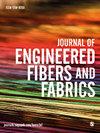超声波焊接工艺参数对帐篷膜剥离强度的影响
IF 2.3
4区 工程技术
Q1 MATERIALS SCIENCE, TEXTILES
引用次数: 5
摘要
超声波焊接是一种通用、清洁、安全的替代连接方法。替代连接技术越来越多地用于满足接缝的特定功能要求,例如在技术纺织品组装过程中实现流体不渗透以实现正连接。本文研究了柔性轻量化纺织材料的超声焊接参数对剥离强度和焊缝厚度的影响。柔性轻量化纺织材料是一种有价值的创新混合纺织品,可用于建筑、建筑和防护纺织品等技术应用。根据焊接宽度为6 mm和12 mm的初步试验结果,选择了3种不同等级的3种主要焊接参数,并采用了叠加式焊缝。采用光扫描显微图像检测了有效焊接部位及其接合界面形貌。分析了超声焊接工艺参数对焊缝质量的影响及其关系趋势。优化剥离强度屈服参数水平也进行了数值评估。结果表明,当焊接速度为2.318 m/min,功率为119.382 W,压力为349.729 N,焊接宽度为12 mm时,剥离强度最佳。焊缝厚度与剥离强度呈反比关系,焊缝宽度减小到12 mm时,焊缝厚度减小量大于6 mm。焊缝的显微截面图表明,在较高的焊接功率和较低的焊接速度下,涂层材料之间存在压缩纱。建立了非线性二次数值模型来预测剥离强度,其结果与实际点的回归对角线接近。对工艺参数对剥离强度的影响进行了统计分析,所得结果具有统计学意义。本文章由计算机程序翻译,如有差异,请以英文原文为准。
Effect of ultrasonic welding process parameters on peel strength of membranes for tents
Ultrasonic welding is a universal, clean, and secure alternative joining method. Alternative joining technologies are used increasingly to fulfill specific functional requirements of the seam, such as fluid impermeability to achieve positive bonding during the assembly of technical textiles. In this research, the effect of important ultrasonic welding parameters on peel strength and weld seam thickness was investigated for flexible and lightweight textile material, which is a valuable innovative hybrid textile for technical applications like architectural, construction, and protective textiles. Three main welding parameters with three different levels were selected based on the preliminary test results of 6 and 12 mm welding widths, and a superimposed type of seam was applied. Light scanning microscopic images were used to examine the effective weld locations and their morphology at the joining interface. The parametric influence of ultrasonic welding technique on-seam quality and their tendencies in the relationship were analyzed. Optimized peel strength yielding parametric levels were also assessed numerically. The result shows that the optimal peel strength value was obtained at a welding speed of 2.318 m/min, power of 119.382 W, and pressure force of 349.729 N for a 12 mm welding width. The weld seam thickness had an inverse relationship with the peel strength, and a higher amount of thickness was reduced to 12 mm welding width than 6 mm. Microscopic cross-sectional image of weld seam indicated that a compressed yarn between the coating material at higher welding power and pressure force in lower welding speed. A nonlinear quadratic numerical model was developed to predict the peel strength, and their results were close to the regressed diagonal line against the actual points. The statistical analysis was carried out to show the significant effect of process parameters on peel strength, whereby the obtained results were statistically significant.
求助全文
通过发布文献求助,成功后即可免费获取论文全文。
去求助
来源期刊

Journal of Engineered Fibers and Fabrics
工程技术-材料科学:纺织
CiteScore
5.00
自引率
6.90%
发文量
41
审稿时长
4 months
期刊介绍:
Journal of Engineered Fibers and Fabrics is a peer-reviewed, open access journal which aims to facilitate the rapid and wide dissemination of research in the engineering of textiles, clothing and fiber based structures.
 求助内容:
求助内容: 应助结果提醒方式:
应助结果提醒方式:


